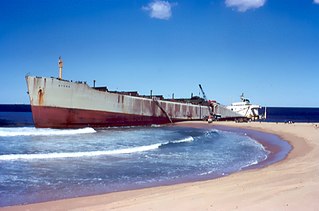
A cargo ship or freighter is a merchant ship that carries cargo, goods, and materials from one port to another. Thousands of cargo carriers ply the world's seas and oceans each year, handling the bulk of international trade. Cargo ships are usually specially designed for the task, often being equipped with cranes and other mechanisms to load and unload, and come in all sizes. Today, they are almost always built of welded steel, and with some exceptions generally have a life expectancy of 25 to 30 years before being scrapped.

A bulk carrier or bulker is a merchant ship specially designed to transport unpackaged bulk cargo—such as grain, coal, ore, steel coils, and cement—in its cargo holds. Since the first specialized bulk carrier was built in 1852, economic forces have led to continued development of these ships, resulting in increased size and sophistication. Today's bulk carriers are specially designed to maximize capacity, safety, efficiency, and durability.

Handymax and Supramax are naval architecture terms for the larger bulk carriers in the Handysize class. Handysize class consists of Supramax, Handymax, and Handy. The ships are used for less voluminous cargoes, and different cargoes can be carried in different holds. Larger capacities for dry bulk include Panamax, Capesize and Very Large Ore Carriers and Chinamax.

MV Sygna was a Norwegian bulk carrier built by Austin & Pickersgill for J. Ludwig Mowinckels Rederi in 1967. It ran aground on Stockton Beach in Australia during a major storm in 1974. After its bow section was refloated, its stern remained beached and became an icon and landmark for the local area, until the visible remains of the wreck collapsed into the sea in 2016.

MV Anthea, previously known as MV Drake, previously known as Pasha Bulker, is a Panamax bulk carrier of 76,741 tonnes deadweight (DWT) operated by the Lauritzen Bulkers shipping company and owned by Japanese Disponent Owners. While waiting in the open ocean outside the harbour to load coal, Pasha Bulker ran aground during a major storm on 8 June 2007 on Nobbys Beach in Newcastle, New South Wales, Australia. It was refloated and moved to a safe location offshore on 2 July 2007 at 9:48 p.m. AEST before being towed to Japan for major repairs on 26 July 2007.
MT Independența ("Independence") was a large Romanian crude oil carrier. She collided in 1979 with a Greek freighter at the southern entrance of Bosphorus, Turkey, and exploded. She caught fire and grounded. Almost all of the tanker's crew members died. The wreck of the Independența burned for weeks, causing heavy air and sea pollution in the Istanbul area and the Sea of Marmara.
Atlantska plovidba d.d. is a Croatian shipping company. Founded in 1955 in Dubrovnik, the company works mostly in the dry bulk and heavy lift markets, serving both domestic and international clients

Sauniere was a self-unloading bulk carrier operated by Algoma Central. Laid down as Bulknes, before launching the vessel's name was changed to Brooknes. The ship was constructed and completed in 1970. The ship was initially owned by the Swedish company Kristian Jebsens Rederi A/S. In 1974, Algoma Central purchased the vessel, registered the ship in West Germany and renamed it Algosea. Algoma Central sent the ship to Swan Hunter in England to be lengthened. Emerging in 1976, Algosea sailed for Canada for conversion to a self-unloading bulk carrier at Herb Fraser and Associates in Port Colborne, Ontario. Algosea, which transported road salt between ports in the Gulf of St. Lawrence, Saint Lawrence Seaway and Great Lakes suffered three collisions and two groundings during its career. The Algosea was renamed Sauniere in 1982 and continued in service until 2009 when the bulk carrier was sold for scrap and broken up in Turkey in 2010.

Algolake was a self-unloading bulk carrier owned and operated by Algoma Central. The ship entered service in 1977 on the Saint Lawrence Seaway. In 1994, the ship ran aground in the St. Lawrence River off Quebec. The ship was laid up for scrapping in 2018, renamed Gola and was later scrapped in Aliağa, Turkey.

Anadolu (L-400) is an amphibious assault ship of the Turkish Navy that can be configured as a V/STOL aircraft carrier. It is named after the peninsula of Anatolia which forms the majority of the land mass of Turkey. The construction works began on 30 April 2016 at the shipyard of Sedef Shipbuilding Inc. in Istanbul, with the keel being laid on 7 February 2018, and is expected to be commissioned in 2022. The vessel is intended to meet the various needs and requirements of the Turkish Armed Forces, such as sustaining long-endurance, long-distance military combat or humanitarian relief operations; while acting as a command center and flagship for the Turkish Navy.
MV Banglar Samriddhi is a Bangladeshi bulk carrier built in 2018 which was struck by a missile in the Black Sea during the 2022 Russian invasion of Ukraine.

MV Yasa Jupiter is a Turkish-owned, Marshall Islands-flagged bulk carrier. It was the first merchant vessel damaged during the 2022 Russian invasion of Ukraine.








